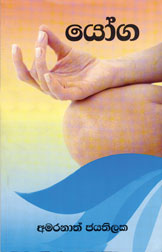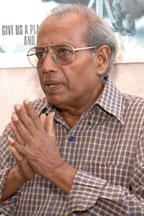Amaranath embraces yoga
  "One standard work written on the subject of Yoga, over a thousand
years ago states: 'It is for children, adults and the aged, for the well
and the ill, for the poor and the rich." "One standard work written on the subject of Yoga, over a thousand
years ago states: 'It is for children, adults and the aged, for the well
and the ill, for the poor and the rich."
There is one condition however - the individual has to do the work
himself. Life, after all, rests only in the individual." - Ernest Wood
Film-maker and film-writer director Amaranath Jayatilaka, is a man of
many parts. He is not only multi-faceted, he is full of surprises as
well. At the recent Sarasaviya Film Awards Festival, he was presented
the Ranapala Bodinagoda Award for enriching film literature. And, what
will surprise many, is the news that he has authored a pioneering work
on Yoga.
Currently, a keen interest in Yoga - bordering upon a fervour -
sweeps, in an enormous wave, right across the face of the earth. A
multitude of global TV channels presents regular programmes on Yoga, in
some of which, those who demonstrate the intricacies of yogasanas are
alluring young women.
Classes, courses of instruction and various training arrangements
that profess to take people through ramifications of Yogic systems, have
become entrenched in most parts of the world, as integral elements in
modern culture.
|
Methods of Yoga
Sankhya Yoga - Yoga by science,
Buddhi Yoga - Yoga by wisdom
Atma Yoga - Yoga of the self
Karma Yoga - Yoga by action
Sannyasa Yoga - Yoga
by renunciation |
Author Amaranath Jayatilaka, has been a kind of Paul Revere, in
raising the alarm against practices that destroy men and women - body
and soul. It was about half-a-century ago, that he initiated his effort,
to keep Sri Lankan readers informed about the urgent need to heed the
perennial wisdom of ancient Yoga Rishis.
Yoga Rishis
Of late, Sri Lanka's interest in the practice of Yoga systems has
begun to burgeon, with the proliferation of Yoga schools and teachers of
Yoga. Some of these are extensively patronized, especially by the
privileged and the affluent. But, author Amaranath Jayatilaka, derived
his awareness of the efficacy of Yoga, from the very fons et origo of
the Yoga System - India. For ages Hindu India, has lived Yoga. From
their birth on, many an Indian receives yogic inspiration, from their
store of legends and epics and the celebrated spiritual heroism of
Yogis. Amaranath Jayatilaka, has always had a marked affinity for the
cultural traditions of India. Given this context, it is nothing but
natural that he should have deeply imbibed Yogic Lore.
For most Indians, the revered Yoga discourses of Patanjali, recorded
about 300 BC, in his well-known Yoga Suthas, is a form of spiritual vade
mecum. Amaranath Jayatilaka, in his cultural sojourns of India,
especially in relation to cinematic events, would undoubtedly have been
touched by the ways of Yoga that influenced the lives Indians,
profoundly. His, book titled 'Yoga', is of 112 pages. The text is
divided into 24 segments of authoritative pronouncements relating to the
essential issues associated with Yoga. The book starts with an earnest
plea to people, to prioritize good health in their lives. He drives this
home by quoting Maharishi Charaka, who avers that above all human
achievements and glorious good health rises as the pre-dominant asset
that ensures life's success. He continues this central theme, stressing
the essential requirement to cultivate the well-being both of the body
and the mind.
The emphasis on physical and mental well-being is decreed by the
fact, that material affluence alone does not guarantee future success.
A highly pragmatic segment in this book in the area in which he sets
down guide-lines for some of the activities we indulge in as elements of
our daily routine of living. He indicates the proper attitude we should
adopt towards such natural habits as eating and sleeping.
 |
|
Amaranath Jayatilaka |
He devotes a whole segment to extol the virtues of sunlight.
Here he unravels the "mystique" of the solar cult, dating from vedic
times. His effort at making the people appreciate the eternal force of
the universal power-house. The Sun - is quite impressive. In the Yoga
system, Breath Control (Pranayama) occupies a central role. According to
Yoga treatises, a human being inhales and exhales 21,600 times day and
night. This explains the emphasis placed on breath-control in the Yogic
System.
Author Amaranath Jayatilaka approaches the segment on the popular
Yogic postures, in the end-segment of his book. He describes twenty of
those, with appropriate illustrations.
We esteem this work as a praiseworthy attempt at guiding people
towards a wholesome way of life, achieving supreme physical and mental
health. Awakening the latent body power and mind power Yoga system
fulfils life, endowing upon people gifts of exceptional intelectual
prowess and supreme physical well-being.
Author Amaranath Jayatilaka opens a new window on the possibilities
of Yoga, to the readers of Sri Lanka, who may not be that familiar with
the ways of Yoga.
I am quite certain, that this is only a beginning and that the Author
will follow this up with an equally impressive series. "Bhagavad Gita",
one of the holiest treatises of the Hindus, sets down different kinds or
methods of Yoga namely
The author will return to his Yoga theme, I am sure, in sequels as
well.
The author believes, in the miraculous efficacy of Yoga. He quotes an
episode, that is utterly compelling. He refers to the instance of Swami
Dhirendra Saraswathy's walk bare-foot in sab-zero temperature in Moscom.
He was clad only in a thin Muslin shirt. Others who had secured
themselves strongly against the indement inclement weather was aghast at
the sight of this, almost unclad Yogi braving the continental freeze. He
did not need help. His yogic training was sufficient.
"Shanti, Shanti, Shanti," was his blessed formula.
|

